Elevating Your eCommerce Game with Conversational AI: A Beginner’s Roadmap
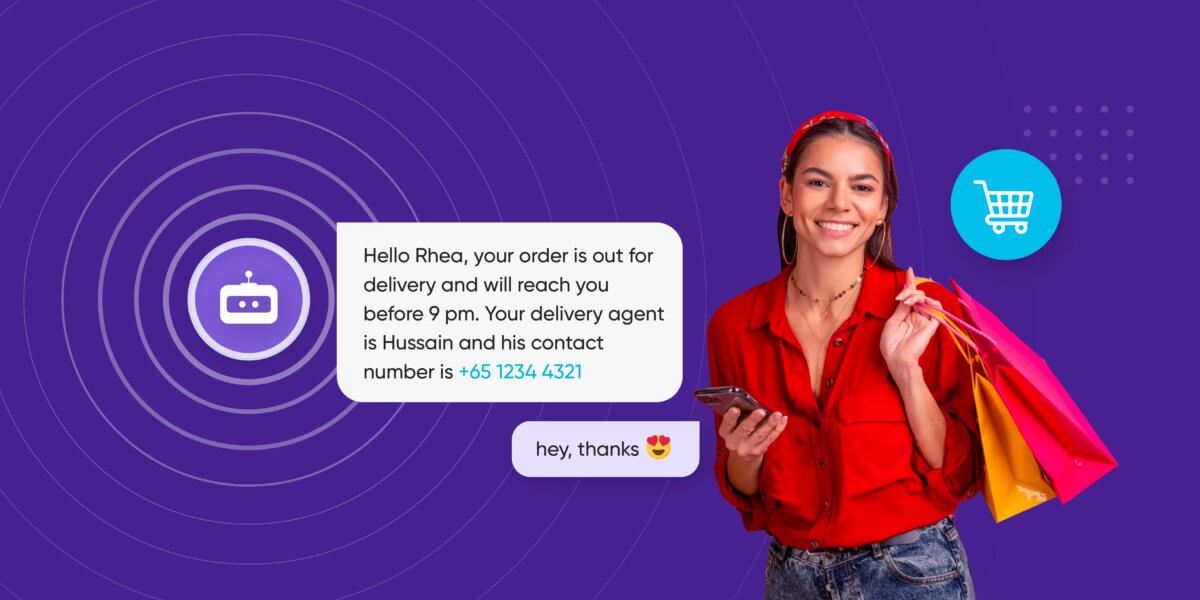
Elevating Your eCommerce Game with Conversational AI: A Beginner’s Roadmap
Whether offline or online, customers expect to search for and order products at their disposal. And intelligent automation helps them do just that. That’s where conversational ai for eCommerce comes into the picture.
Why now?
E-commerce skyrocketed last decade with changing customer demands and newer tech changes to supplement the transformation. The e-commerce market share is forecasted to grow by 50% over the next three years, reaching about 7.4 trillion dollars by 2025 as per Statista.
At the same time, customer preferences are changing. With the advent of mobile technology, social media and AI, people are preferring to communicate with businesses through messaging apps.
Conversational AI for eCommerce knits customer expectations and an outlet to fulfil them together – Users are looking for an end-to-end shopping experience in a single chat window and conversational AI helps businesses achieve that.
It comes as no surprise, the chatbot industry is gaining momentum. According to estimates, the global conversational eCommerce market size is poised to grow from USD 6.8 billion in 2021 to USD 18.4 billion by 2026.
The writing is on the wall: E-commerce marketers should strategise ways to drive a holistic and convenience-driven e-commerce experience–one that can drive profits as well as productivity, and maintain a happier customer base.
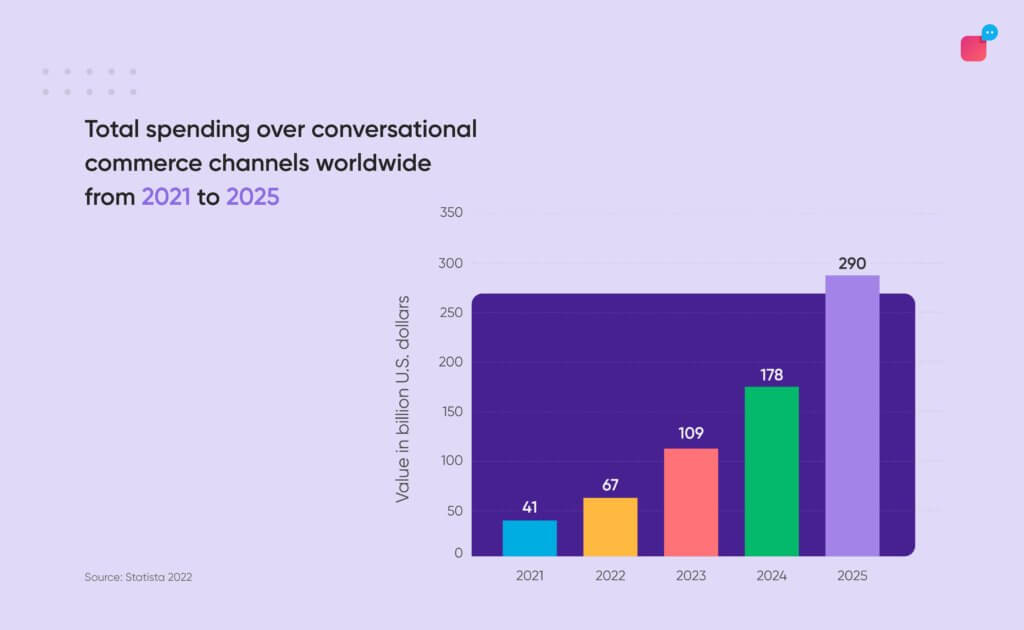
Conversational AI for eCommerce: Definition and Overview
Conversational AI for eCommerce is a way for businesses to sell their products through social interactions on social platforms. These ‘conversations’ are often driven by leveraging AI-powered conversational tools such as live chat, chatbot, voice assistants etc. on e-commerce websites, messaging apps, and social media pages.
The end goal with chatbots for eCommerce is to deliver a personalised user experience and help customers move along the sales funnel quickly.
Let’s look at a real-life example to understand this well.
Case Study: How L’Oréal Achieved One Month of Sales in 24 Hours Using Conversational AI
Problem statement: During the pandemic, beauty giant L’Oréal (Malaysia division) wanted to drive engagement and boost sales.
Strategy: The brand leveraged live streaming services on Facebook and conversational ai for eCommerce capabilities to drive a 12-hour long virtual beauty festival. High-end brands–from YSL and Armani to Urban Decay and IT Cosmetics–promoted their products using celebrities and influencers who hosted giveaways and flash sales:
L’Oréal used a dedicated hashtag to trigger private conversations on Messenger Chatbot between the consumer and an available beauty expert. The customer could use this space to get instant answers for their questions, build carts, place orders, and make payments, all from the same place.
A Real-Life Advisor Taking Customer Orders during the Livestream and Initiating Payments using a Private Chat
The result: The brand was able to sell one month’s worth of online sales in a span of 24 hours. During this time, L’Oréal started over 17,000+ chats and reached out to 2.6 million people with an impressive post-engagement rate of 12%. The sales quadrupled (compared to the daily average) and customer engagement deepened, ultimately boosting the bottom line.
The takeaway: By enabling shopping via chat, e-commerce brands can drive a convenience-driven customer experience and shorten the path between intent and purchase.
Examples of Conversational AI: Ways in Which You Can Implement It in Your eCommerce Business
There’s no ‘one-size-fits-all’ approach that can be used to drive conversational ai for your eCommerce business. Depending on your brand goals, customer expectations and needs, industry type, and changing business requirements, you can chart out an ROI-driven eCommerce strategy. If you have a platform that supports chat and/or voice functionalities, you can leverage conversational AI to boost user engagement and sales (directly impacting your revenues and profits).
Here are the top 3 ways to use a technology like conversational AI.
Voice AI/Voice assistants
Voice assistants are a conversational AI tool that can understand natural language and answer similarly. Your user can use your e-commerce voicebot to get timely answers to questions that otherwise would hamper their product search. And it can do it all hands-free! E-commerce brands can even integrate voice commerce technology with their mobile apps. Some of the best practices you can use to deploy your own voice AI can be:
- Build using all utterances that come into account for any user journey
- Handle errors with multiple iterations in responses
- Humanise your voicebot with a personality
Here’s our in-depth resource on the best practices to employ if you want to build and scale with voice AI.
Conversational Chatbots
You can integrate a chatbot for eCommerce on your website’s landing page, within your mobile applications, or even within messaging platforms like WhatsApp, Viber, etc. Chatbots provide multiple options to make conversations interactive, such as buttons for quick response, rich media to showcase products, integration with CRM, payment gateways, etc. And if a user is stuck somewhere, they can always connect to an agent and complete their conversation.
To ensure that your chatbot is able to drive meaningful conversations, follow these best practices:
– Ensure that the chatbot language is conversational and human.
– Monitor the right kind of success metrics to gauge efficiency.
– Gather chat transcripts and drive post-chat surveys to understand what’s working (and what’s not).
– Make sure that the chat opening and closing interactions are impactful.
Live Chat
Live chat support has a live agent to answer questions from the other end. You can integrate the live chat functionality within your brand’s mobile app and website, and for social apps like WhatsApp, Instagram and Facebook. By giving this option, your users can interact with a human agent who can help them find relevant products, provide quick information and complete the purchase.
To make the most of this functionality, follow these best practices:
- Put a ‘name’ and ‘face’ to the live chat agent to humanise the chatting experience.
- Always use a typing indicator to let the customer know that there’s someone present at the other end.
- Ensure that your live chat agent’s grammar game is on-point.
- Make use of emojis and speak in the language that your end-customer prefers.
- Always route chat to the relevant agent.
Social Commerce
Social commerce is the way of selling products on social media platforms with user contributions and social interactions. Businesses can choose to deploy chatbots or live chat support on platforms like Instagram, Facebook, and Twitter. With the API functionality, these channels can be integrated with conversational AI platforms and carry out conversations at scale.
- Leverage user-generated content to spread your word and build strong social proof.
- Partner with social influencers to boost your awareness and sales.
- Integrate your social handles with your e-commerce store.
How to Lead Users to Customers with Conversational AI During the User Journey
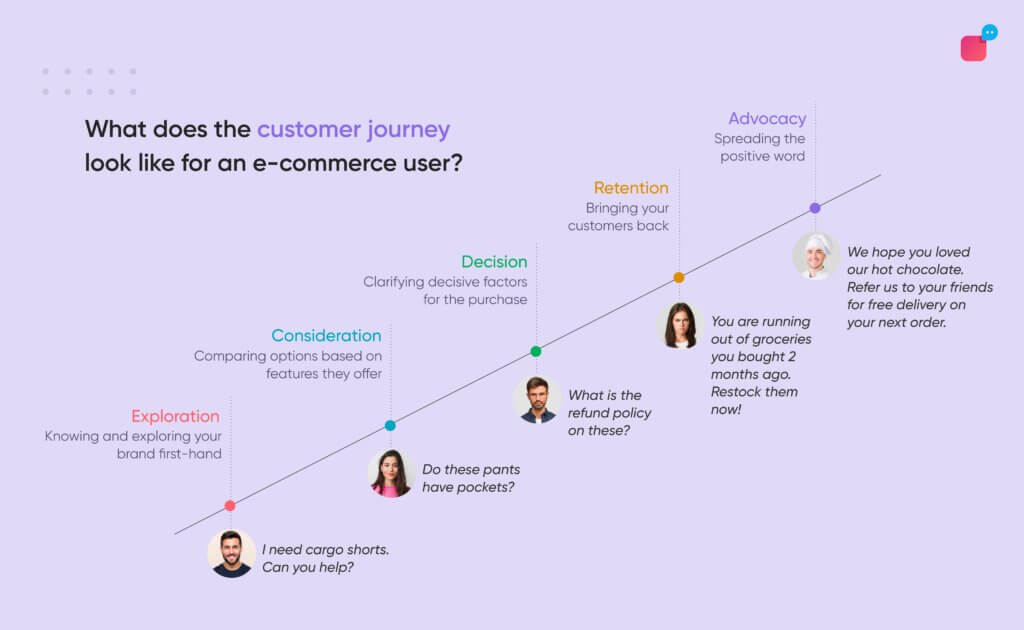
Conversational AI, when used right, can initiate a meaningful two-way conversation with customers and help brands to build lasting relationships with users.
In this section, we will provide a step-by-step lowdown of how e-commerce stores can leverage conversational AI at every stage of the customer’s purchase journey, which typically comprises of five stages:
Stage 1: Awareness
In this stage, e-commerce brands can leverage conversational tools to connect with customers who want to know more about their products or services. For instance, brands can use chatbots/live chat on the website/app and proactively drive conversations with users who land on your e-commerce platform looking for a product.
Proactively connecting with your visitors can boost engagement and increase their chances to convert. Your conversational AI tool can assist these casual visitors with the right information about relevant products to push them down the funnel.

Stage 2: Consideration
At this stage, your users are looking for that one differentiating factor that helps you stand out from the rest. In this case, it could be your stellar customer support.
The consideration stage is an extension of the awareness stage, where customers end up comparing your brand’s offerings with that of the competitor and actively read user reviews as well as testimonials. For example, the quality of the product you are offering them can be a defining factor for a user who is comparing your business with others in the market. Here is a chat example of engaging with a user in the consideration stage:

Stage 3: Decision
This stage is all about gaining the customer’s confidence by reassuring them that they’ve made the right choice. They are now at a stage where they will either buy from you or skip to the next best option at a moment’s notice. Your conversational AI tool can clarify key decision-making factors like delivery charges, payment methods, estimated delivery time, refund timelines and policies, in real-time.
The end goal is to resolve customer issues and eliminate friction points as quickly as they appear, leading to a positive user experience and a happier customer.
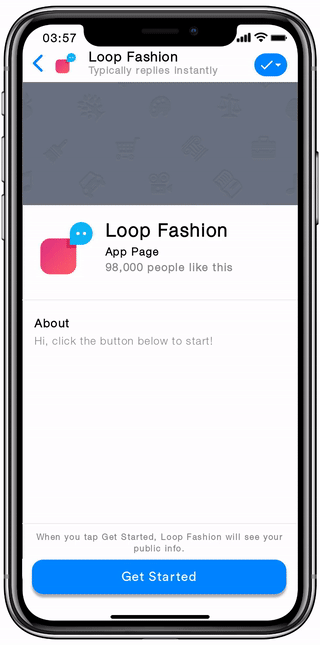
Stage 4: Retention
The final stage of the customer journey is advocacy. In this stage, the customer becomes self-confessed brand ambassadors and voluntarily recommends products to their friends and family. In this stage, leverage conversational AI to ask customers for their valued opinion and gather product reviews. You can also gather real-time customer feedback and improvise on ways to enhance the customer experience based on the inputs received.
Additionally, you can even encourage referrals in exchange for deals to widen your reach. Your happy customers will more likely talk about your business positively with their peers.
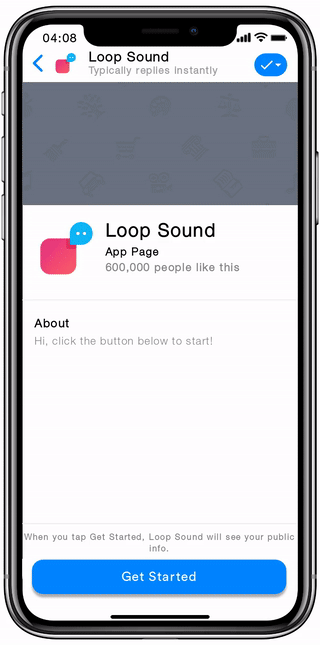
Stage 5: Advocacy
The final stage of the customer journey is advocacy. In this stage, the customer becomes self-confessed brand ambassadors and voluntarily recommends products to their friends and family. In this stage, leverage conversational AI to ask customers for their valued opinion and gather product reviews. You can also gather real-time customer feedback and improvise on ways to enhance the customer experience based on the inputs received.
Additionally, you can even encourage referrals in exchange for deals to widen your reach. Your happy customers will more likely talk about your business positively with their peers.

But Why is Conversational AI Needed for Every Touchpoint in The User Journey?
- It reduces the number of steps aka effort the customer has to take to complete an action, making the experience convenient and quick.
- It helps e-commerce brands to establish a two-way relationship with the customer by driving proactive and personalised conversations.
- It allows customers to seek answers quickly, without jumping from one channel to the next. Instead of forcing customers to be present on the brand’s preferred channel of communication, the brands go to the customer’s channel of choice
You’d also love to know: How an e-commerce brand is driving interactions across multiple verticals with conversational AI!
Kanmo Group is a multi-brand e-commerce company headquartered in Indonesia. Tackling multiple queries pouring in from every possible channel became a task for the company.
This is when Kanmo Group decided to switch to conversational automation to lead its e-commerce customer support. They deployed a multilingual chatbot, fluent in Bahasa Indonesia on Facebook for its brands to cater to the majority of Indonesian customers. With a unified customer profile, Kanmo Group was able to manage all its conversations from different brands on one platform.
By integrating with Google Hangouts, Kanmo Group took its customer support stratergy a grade up as the support agents could now also guide users on video calls throughout the buying process.
How did the numbers play out?
With conversational AI, their response times improved by over 40% with the chatbot handling 42% of all chat conversations.
Conversational Technologies and Tools that Drive eCommerce
Conversational AI platform providers such as Verloop.io provide many features that facilitate meaningful interactions that lead to people successfully completing their journeys and in turn, conversions.
At the same time, Meta’s social media suite offers many native selling features that propel eCommerce technologies on platforms. The reach these social apps possess is a goldmine for any business looking to build an audience. Let’s take a look at how Facebook, Instagram, and WhatsApp enable social commerce.
Businesses can add a shop tab on their Facebook Business page where they can list catalogues of products for customers’ easy viewing. The catalogue feature is also available for WhatsApp Business users (yet to be launched for WhatsApp Business API) and Instagram. However, businesses can send curated multi-product messages in which you can send a collection of up to 30 items with the WhatsApp API. These highly personalised curated messages are defined based on the user’s preference and history. Additionally, WhatsApp now allows its Indian users to shop and pay on the go on WhatsApp with WhatsApp Pay.
The On-Page shop tab on Facebook allows customers to purchase products from your business page. The dynamic ads feature prevents you from creating individual ads for each of your products. This feature works great if you have multiple products to promote. With the new Facebook Live Shopping feature, you can even sell your products on your live-streamed shopping events. Your customers can instantly start chats and buy directly from your business’ live events.
Instagram’s product listings can click to reveal product details that a chatbot can further expand on and answer additional questions a user may have. Users can also browse similar products under collections. With the Instagram API, the agents get a whole lot of new features to engage with customers and help them complete purchases in the same chat window.
All your Facebook, Instagram and WhatsApp click-to-chat ads can be redirected to your conversational chatbot that can then attend and guide the customer along the journey.
Conversational AI Benefits: A 360-degree Perspective
Conversational AI applications such as live chat, voice search, chatbots, etc. are becoming an everyday phenomenon as Gen Z and millennials actively prefer these forms of communication. Let’s first take a look at the benefits these technologies offer and then deep-dive to understand the emerging trends.
1. Personalised, Responsive, and Real-Time Service
One of the biggest advantages of using automation is the ability to add a ‘personal’ touch to the online customer experience (CX), marketing, and sales strategies via text, chat, and video chat.
After all, at the heart of commerce lies human interactions. In other words, if brands wish to drive a more tailored, quick, and user-friendly experience, they should leverage the right automation tools depending on their overall business strategy.
With the advancement of technology, conversational tools are no longer robot-like; they’re increasingly becoming more human-like, capable of driving value-driven, customer-centric conversations.
2. Better Brand Affinity
According to research, 75% of consumers will spend more with a brand if they have the option of messaging (not calling) them.
Brands can leverage tools such as live chat, Messenger platforms, etc. to support and build relationships with customers. Moreover, research by Facebook indicates that “69% of consumers who message businesses say that being able to message a business helps them feel more confident about the brand.” If businesses want to get into the customer’s ‘good books,’ conversational AI might be their calling.
3. Reduced Cart Abandonment Rates
According to data, the average cart abandonment rate stands at 69.82%. Therefore, applications such as live chat, Facebook Messenger, etc. can be used to connect with customers proactively, offer support. At the same time, consumers place their orders, and extend personalised suggestions based on past purchases or items in the cart. Conversational AI can also incentivise customers to complete the purchase process.
4. Improved Profits
Conversational AI is capturing the e-commerce market rapidly with each passing day. Applications like chatbots and voice technology are estimated to bring in $290 billion by 2025. The takeaway: AI tools and technology are growing from strength to strength, paving the way for a seamless and customised user experience. Brands are investing time, effort, and money to build lifelike conversational tools at cutting-edge technology’s forefront.
Automation in eCommerce: Future Trends and Developments to Look Out For
1. Widespread Use of AI-Led Chatbots in eCommerce
An overwhelming 1.4 billion people are using chatbots today. Furthermore, research also suggests that chatbots will account for 50% of eCommerce spending. Regarding market spending, the global chatbot market will reach $1.34 billion by 2024. While chatbots have always been used to drive a stellar customer support experience, it is also branching out to sales.
Over the past year, there has been a mind-blowing 534.17% jump in incoming chat conversations for e-commerce brands! This number comes from our annual E-commerce Benchmark Report for 2021, where we analysed 11.4 million interactions across 80+ brands!
Get your copy of the report today so you can set YOUR benchmark right for the coming year.
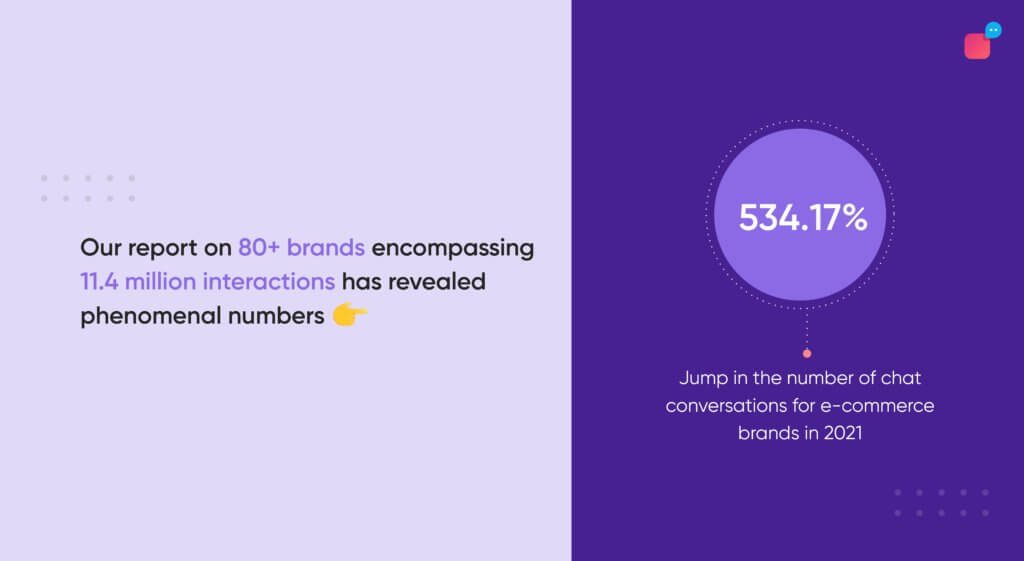
2. Voice Assistants and Search are Gaining Traction
Once considered to be nascent technology, the use of voice search is steadily catching eyeballs. According to Statista, by 2024, the number of digital voice assistants will reach 8.4 billion units.
By 2022, 55% of households will own a smart speaker. For local businesses, voice search will double up as a goldmine as 58% of consumers use voice search to find local businesses. Additionally, people also use voice search to ask for quick facts, directions, search for products/services/businesses, make a shopping list, etc.
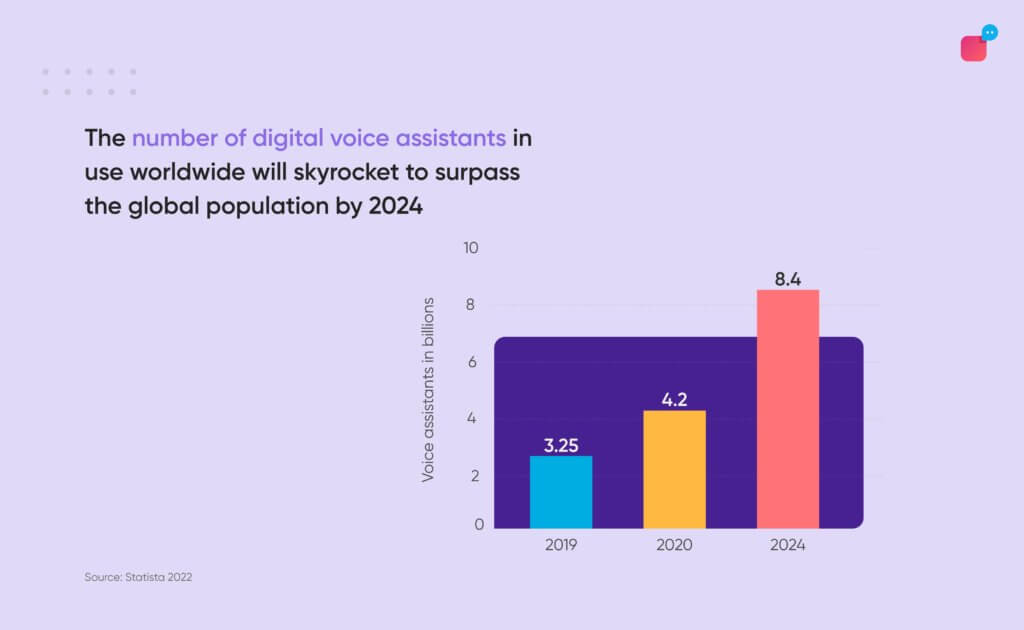
3. Live Chat is Here to Stay
Around 91% of customers demand real-time assistance today. After all, live chat can help customers find answers to questions instantly, without the wait time. This can elevate the user satisfaction rates for 73% of customers and boost the conversion rates by up to 82%. Live chat adds a human touch to the interactions and makes it instantaneous, adding unparalleled levels of convenience.
The takeaway: The growth from Conversational AI in eCommerce businesses is exploding and showing no signs of a slowdown. According to Capgemini, the daily AI-driven interactions between customers and brands in the US increased by almost 40% between 2018 and 2020. Numerous factors are fueling this skyrocketing growth such as evolving customer behaviour, advancements in AI technology, and so on. Needless to say, industries across the board will find it in their best interest to invest in this robust technology.
Role of Conversational AI in Different Industries
As per the latest research, there has been a 400% increase in the retail chatbot trends. Clearly, conversational AI is increasingly forming an integral component of the Retail industry. The options are aplenty, from web-based chatbots and Messenger bots to voice assistants and live chat. It has been seen that the launch of Amazon Echo smart speakers in 2014 helped Natural Language Processing gain greater focus in retail.
Conversational AI in retail offers 360-degree benefits such as:
- Faster, seamless, personalised, and convenient buying experiences
- Reduced customer churn and lower customer service costs
- Agility in terms of purchase decisions and innovating the customer experience with greater flexibility
Key technologies retail brands can leverage to develop an all-round conversational strategy:
- AI-powered chatbots that can provide instant and personalised recommendations to customers using messaging platforms, mobile, or web as H&M’s chatbots demonstrate below:
1. Conversational AI in Retail
Conversational AI for brands has emerged as a strategic imperative today. Industries worldwide are benefiting from this futuristic technology. This section will look at how this technology is revolutionising the Retail, Automotive, and Banking industries.
Top-3 Industry-Applications of Conversation Commerce for Businesses
Conversational AI in Retail
As per the latest research, there has been a 400% increase in the retail chatbot trends. Clearly, conversational AI is increasingly forming an integral component of the Retail industry. The options are aplenty, from web-based chatbots and Messenger bots to voice assistants and live chat. It has been seen that the launch of Amazon Echo smart speakers in 2014 helped Natural Language Processing gain greater focus in retail.
Conversational AI in retail offers 360-degree benefits such as:
- Faster, seamless, personalised, and convenient buying experiences
- Reduced customer churn and lower customer service costs
- Agility in terms of purchase decisions and innovating the customer experience with greater flexibility
Key technologies retail brands can leverage to develop an all-round conversational strategy:AI-powered chatbots that can provide instant and personalised recommendations to customers using messaging platforms, mobile, or web as H&M’s chatbots demonstrate below:
Key technologies retail brands can leverage to develop an all-round conversational strategy:
- AI-powered chatbots, that can provide instant and personalised recommendations to customers using messaging platforms, mobile, or web as H&M’s chatbots demonstrate below:
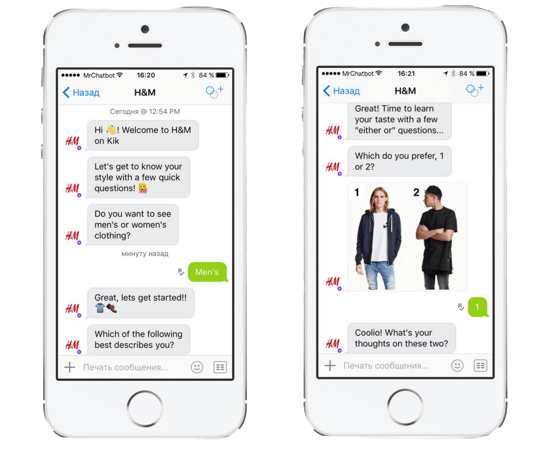
- Voice assistants, can be used as an alternative to the inflexible IVR (interactive voice response) systems as well as AI-powered call centres.
According to research by Deloitte, the commerce market size is growing at more than 20% each year, and more than 10 billion customer-brand interactions will occur within the next few years. In simpler words, retail brands need to start scaling their e-commerce operations today to be better prepared for the limitless needs of tomorrow.
Conversational AI in Banking
Owing to the COVID-19 pandemic, the conversational AI trend has picked up within the banking sector, with over 75% of financial institutions considering leveraging conversational AI, data, and analytics.
Key technologies banking companies can leverage to develop an all-round conversational strategy:
- Chatbots, which can drive end-to-end customer interactions and answer routine customer queries instantly as ADIB’s chatbot demonstrates below:
Conversational AI in Banking
Owing to the COVID-19 pandemic, the conversational AI trend has picked up within the banking sector, with over 75% of financial institutions considering leveraging conversational AI, data, and analytics.
Key technologies banking companies can leverage to develop an all-round conversational strategy:
- Chatbots, which can drive end-to-end customer interactions and answer routine customer queries instantly as ADIB’s chatbot demonstrates below:
In fact, according to Juniper Research, a staggering 90% of customer interactions in banks will be automated by 2022 using chatbots. Voice assistants, which can provide answers to user queries by talking, texting, or tapping. For example, US Bank’s Smart Assistant™ is a voice-enabled virtual assistant (VA) that users can use with its mobile app:

In fact, according to Juniper Research, a staggering 90% of customer interactions in banks will be automated by 2022 using chatbots.
- Voice assistants, which can provide answers to user queries by talking, texting, or tapping. For example, US Bank’s Smart Assistant™ is a voice-enabled virtual assistant (VA) that users can use with its mobile app:
- Video banking empowers customers to speak to a video banker anytime, anywhere from an app, tablet, or computer. Barclay’s video banking feature is an interesting case in point which allows customers to chat with a bank executive and successfully replicates an in-person visit at the click of a button:
There’s plenty of scope for conversational AI within the Banking sector such as providing high-quality customer service, driving proactive customer engagement, reducing customer support requests with accurate query resolution, etc.
There’s plenty of scope for conversation commerce within the Banking sector such as providing high-quality customer service, driving proactive customer engagement, reducing customer support requests with accurate query resolution, etc.
Conversational AI in Travel and Hospitality
Besides the banking industry, the next sector that benefits greatly from real-time conversational assistance is the travel and hospitality industry. Flyin, a Cleartrip OTA company, deployed conversational intelligence to manage all its bookings on various platforms. With the help of an omnichannel chatbot, Flyin was able to deflect 84% of all its support tickets, and brought down its FRT to mere seconds.
Key technologies retail brands can leverage to develop an all-round conversational strategy:
- Chatbots, that can answer all frequently asked questions travellers may have during the booking process like the refund policy, pricing, COVID-19 travel restrictions, and more.
Voicebots, on the other hand, can be the traveller’s handy tool on the go. They can help the user access information as and when the user needs it. For example, the hands free support can be particularly useful when a user is in a hurry and needs to access their boarding pass. A simple “Hey I need my boarding pass quickly” will trigger the voicebot to send the boarding pass to the user in real-time.
Real-Life Examples of Brands using Conversational AI Technologies
Today, increasingly companies have started harnessing the power of conversational AI and eCommerce for a myriad of reasons–from marketing products to the targeted customer to addressing their pain points in real-time. The pandemic has encouraged brands to apply AI-based solutions to elevate the customer experience while reducing costs and positively impacting the bottom line.
Let’s move on to understand how different brands are leveraging conversational AI solutions and tapping into the power of AI-driven conversations:
1. Meet Nykaa’s eCommerce Chatbot:
Nykaa, one of India’s leading beauty brands, had a phenomenal time last year. Beginning as an ambitious bootstrapped venture, Nykaa went public, launching its IPO in October 2021. This comes as no surprise since the brand has seen remarkable progress over the past 10 years since it started in 2012.
With steady growth comes a challenge – reaching and connecting with the large user base with a personal touch. Building customer relationships with active and timely dialogue became a task for Nykaa.
As Nykaa touched soaring heights, conversational AI became the brand’s trusted companion. Nykaa’s smart conversational bot handled over 1.5 million unique customer interactions within 30 days of getting deployed. That’s the power of conversational AI done right.
With an option to choose “Beauty advice”, consumers were redirected to Nykaa’s in-house experts who are available to assist users. The expert would then interact with the user to better understand what they need – products that suit their skin or hair type, ingredients that they need in their beauty product, and more.
This way the expert can fully assess and recommend what’s best for the user. Now, instead of getting lost in a product catalogue of thousands of products, users could now reach what they need, without wasting time.

2. Meet Sephora’s Facebook Messenger Bots:
Sephora leverages two types of Facebook Messenger bots:
A. Sephora Reservation Assistant: This is an appointment booking bot that can help users make a makeover reservation at Sephora stores:
According to data, the bot has seen an 11% rise in conversion rate versus any other channel for booking in-store makeover appointments.
B. Sephora Virtual Artist: This shade matching bot offers a multitude of features. Users can:
- Scan an image, object, or face of a celebrity and view a list of matching lipsticks
- Get access to useful makeup tips, ‘how-to’ videos, and reviews
- Be redirected to the brand’s mobile site or app for purchase
3. Meet Domino’s Pizza’s chatbot:
Domino’s chatbot is another example of a multi-purpose Facebook Messenger chatbot. This bot can help customers to order from the menu, without leaving Messenger, leading to a convenient and quick user experience. Interestingly, the chatbot is also able to re-order the customer’s previous orders if the user has linked their Facebook account to Domino’s account. Additionally, the chatbot can track the user’s order and provide an accurate time of delivery.
Long story short, solutions for eCommerce with Conversational AI are on the rise, and for good reason. The organic use of these bots leads to cost-savings, improved customer experience, greater profitability, and brands gaining a strategic edge – a win-win for all.
Conversational AI for eCommerce with Verloop.io – The Better and Faster Way to eCommerce
Conversations bring ease. In a personal setting, at work, or even during shopping online – timely communication only avoids confusion. This in turn helps you form better relationships with people you are talking to. This couldn’t hold truer in the e-commerce world as well.
Conversational AI is not only simplifying shopping for users but also boosting revenue for businesses. The total spending on eCommerce channels is set to skyrocket from $41 billion in 2021 to $290 billion by 2025.
This is 7x growth in just 4 years.
Evidently so, conversational AI is the future of e-commerce brands worldwide. But how can YOUR e-commerce business capitalise on this?
Here’s where we come in!
Verloop.io is revolutionising the e-commerce space with conversational AI. With training datasets geared specifically towards e-commerce, your eCommerce solutions voice and chat AI can solve daily use cases your business sees.







